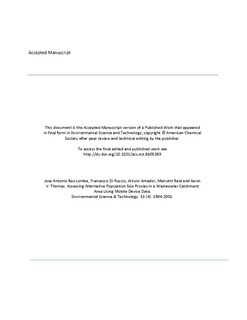| dc.description.abstract | Modeling and prediction of a city’s (Oslo, Norway) daily dynamic population using mobile device-based population activity data and three low cost markers is presented for the first time. Such data is useful for wastewater-based epidemiology (WBE), which is an approach used to estimate the population level use of licit and illicit drugs, new psychoactive substances, human exposure to a wide range of pollutants, such as pesticides or phthalates, as well as the release of endogenous substances such as oxidative stress and allergen biomarkers. Comparing WBE results between cities often requires normalization to population size, and inaccuracy in the measured population can introduce high levels of uncertainty. In this study mobile phone data from 8-weeks in 2016 was used to train three linear models based on drinking water production, electricity consumption and online measurements of ammonium in wastewater. The ammonium model showed the best correlation with R2 = 0.88 while drinking water production and electricity consumption showed more discrepancies. The three models were then re-evaluated against 5-week of mobile phone data from 2017 showing mean absolute errors <10%. The ammonium-based estimated mean annual population for Oslo in 2017 was 645 000 inhabitants, 4% higher than the “de jure” population reported by the wastewater treatment plant. Due to changing conditions and seasonality, drinking water production underestimated the population by 27% and electricity consumption overestimated the population by 59%. Therefore, the results of this work showed that the ammonium mass loads can be used as an anthropogenic proxy to monitor and correct the fluctuations in population for a specific catchment area. Furthermore, this approach uses a simple, yet reliable indicator for population size that can be used also in other areas of research. | nb_NO |
